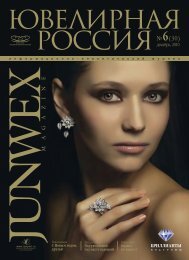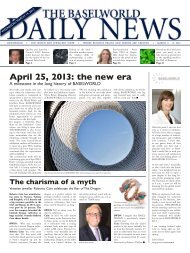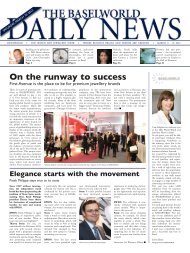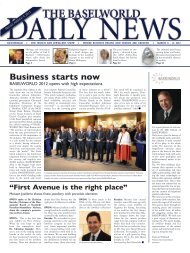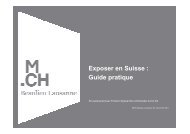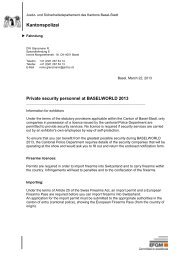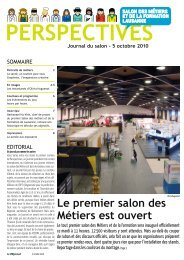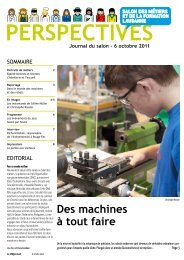WatchTime - August 2012
WatchTime - August 2012
WatchTime - August 2012
Create successful ePaper yourself
Turn your PDF publications into a flip-book with our unique Google optimized e-Paper software.
sition. After six hours the same tiles will be<br />
in the center of the dial and form an hour<br />
number. However, the tiles will be turned<br />
180 degrees. In the same way, the entire<br />
system is shifted by 180 degrees. For example:<br />
the top left tile of the “11” (see photo)<br />
will become the lower right tile of the<br />
“5” after six hours – that is, its flip side,<br />
which after another six hours will again be<br />
the top left tile of the “11.” Within this period<br />
the satellite will have moved four<br />
times around the triangular gear and its arbor<br />
will have turned 30 times along with<br />
the tile.<br />
The large wheel, which is driven by the<br />
barrel, continues to advance 90 degrees<br />
during an hour transition, in order to return<br />
to the same place after four hours. Its<br />
four satellite wheels will also be in the<br />
same position after four hours, but not its<br />
three additional satellites with their tiles.<br />
They will move 120 degrees during each<br />
transition, making one revolution around<br />
the triangular gear after a three-hour period.<br />
However, they do not return to the<br />
same configuration they were in three<br />
hours earlier. The tiles are now in a different<br />
location in relation to one another. In<br />
pairs, they alternately complete two or<br />
three half turns every time they change position.<br />
The triangular gear and the elliptical<br />
gears are designed so that they can vary<br />
these transmission ratios. This allows the<br />
tiles to pass by one another without colliding<br />
and to reappear in the center at the<br />
proper time. After three hours, the same<br />
satellite will again be in the center but<br />
show the reverse side of the tile. Depending<br />
on the tile, it will have turned seven or<br />
eight times, 15 times in six hours, or 60<br />
times a day.<br />
The incredible calculation and design<br />
work behind the hour-changing mechanism<br />
of the Opus XI was only made possible<br />
with computer programs that weren't<br />
even designed a few years ago. Today<br />
these programs can calculate, analyze,<br />
draw and optimize the tooth shape of the<br />
triangular and elliptical wheels and how<br />
they mesh. The wheels themselves were<br />
created through the use of photolithography<br />
– a process where tiny components<br />
can be manufactured with a precision<br />
that cannot be achieved with conventional<br />
manufacturing methods. The conical<br />
Denis Giguet, the brains behind Opus XI<br />
pinions for the bevel gears, for example,<br />
are just 1.2 mm wide. Their shape, angles<br />
and teeth are perfectly accurate thanks to<br />
this new manufacturing technology. The<br />
shape and path of each tile was also calculated<br />
using computer technology in order<br />
to minimize the space required for the<br />
switching action. The case and sapphire<br />
crystal, which themselves are the result of<br />
complicated production processes, offer a<br />
broad view of the astonishing hourly<br />
movements. You may enjoy the exhilaration<br />
of a wild carnival ride – with the<br />
Opus XI it occurs once every hour.<br />
As you might guess, Denis Giguet is<br />
no newcomer to avant-garde horology.<br />
Trained as an engineer, he served as head<br />
of production for Harry Winston. In<br />
2007 he launched his own brand, Manufacture<br />
Contemporaine du Temps<br />
(MCT), and designed its flagship watch,<br />
the Sequential One – in which the hour<br />
numerals are each composed of five<br />
prism-like segments, arranged like slats in<br />
a Venetian blind, which flip over to form<br />
a new numeral at the appropriate time.<br />
Twenty technical specialists worked with<br />
Giguet to develop the Sequential One.<br />
They included Eric Giroud and Jean-<br />
François Mojon, who collaborated with<br />
Harry Winston on, respectively, Opus IX<br />
and X. <br />
<strong>August</strong> <strong>2012</strong> <strong>WatchTime</strong> 111



